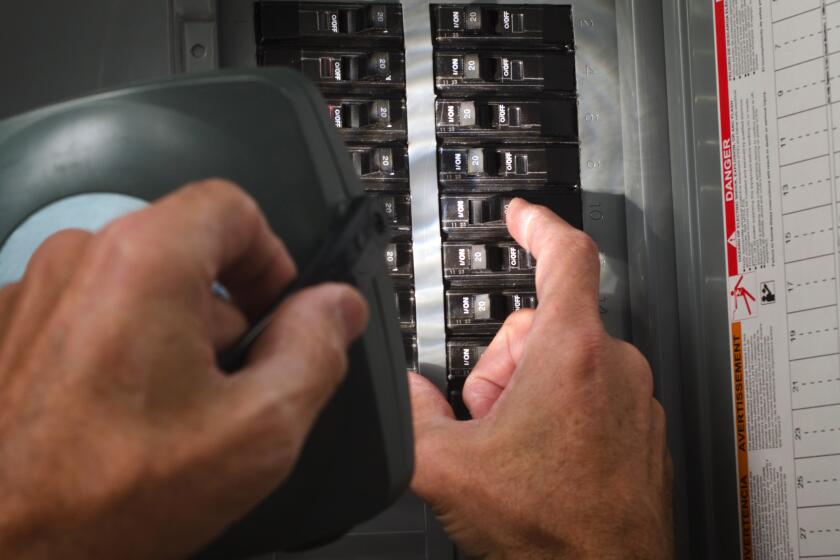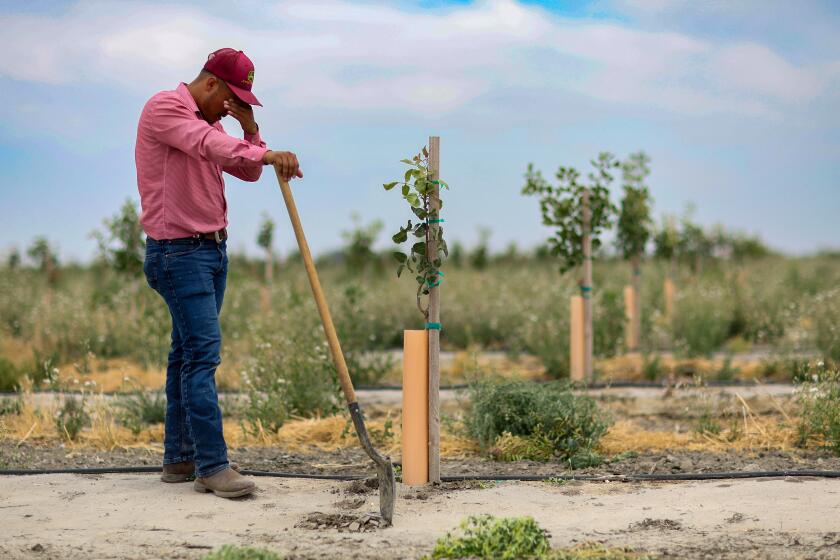1965 Fallout Hits a Suspicious L.A. : Health: Area officials say they were unaware of a radioactive cloud that was sent over the city. Atomic agency officials minimize hazards.
They were seemingly unrelated front-page news events on Jan. 13, 1965: Government scientists in Nevada had intentionally blown up a nuclear rocket, and the Santa Ana winds had begun pushing warm desert air “from a high pressure front in Nevada” into the Los Angeles Basin.
But they were more than coincidence. Newly released records show that Atomic Energy Commission officials had been waiting for the unusual southwesterly wind pattern in order to gauge the possible environmental effects of a major launch pad disaster involving nuclear rockets then being tested for the space program.
Unbeknown to the Southern California public and most local officials, the radioactive cloud from the blast was tracked 200 miles as it moved across California, over Los Angeles and out over the Pacific Ocean.
Nearly 30 years later, news of the radioactive cloud, which officials insist was harmless, has landed in a far more suspicious and environmentally conscious Los Angeles than existed when hilltop missile bases guarded against foreign nuclear attack and police officers were equipped with Geiger counters.
“The scare was more from the Soviet Union than . . . our own testing,” said retired City Engineer Donald Tillman, who sat on Los Angeles’ Civil Defense and Disaster Board in the mid-1960s. “I think most people had a feeling that these tests (were necessary) and they expected the Defense Department to protect us.”
Since those days, another era has dawned. An anti-nuclear movement has been born. Disaster has struck at Chernobyl and Three Mile Island. There has been a series of disclosures about Cold War-era government testing programs using unwitting citizens.
Indeed, Rep. Edward J. Markey (D-Mass.), who released details Wednesday of Los Angeles’ nuclear cloud, has charged that about 6 million area residents may have been used as human guinea pigs in the experiment. He has called on the Department of Energy to include the incident in a series of government human radiation experiments being reviewed by scientists to determine if compensation or follow-up medical care is warranted.
“It’s further evidence that the nuclear industry has been quite careless throughout its history,” said Joseph Lyou, who directs the Committee to Bridge the Gap, a Los Angeles nuclear watchdog group. Lyou said his group’s rough estimates suggest a few among the millions of people living here at the time might have died or contracted cancer as a result of the radiation exposure.
That assessment was sharply disputed Thursday by agencies involved in the experiment, including the Los Alamos National Laboratory, which conducted the test for the old Atomic Energy Commission. “It was such a small amount (of radiation) by the time it got to the border of the test site it wasn’t anything to get excited about,” said John Gustafson, a laboratory spokesman. Gustafson said Los Alamos physicists estimate that the exposure levels in Los Angeles were a fraction of a millirem--far less than the added radiation received in many routine activities, including flying across the country in an airplane.
What seems clear is that few knew at the time that the cloud was quietly drifting over Los Angeles. Several political and government officials said Thursday that they were surprised by the disclosures and should have been informed at the time.
“You would have all sorts of investigations by the Fire Department and the supervisors would have asked what went wrong (and the) congressional representatives of Los Angeles to investigate,” said former county Supervisor Kenneth Hahn, who was a leader in Cold War civil defense planning issues and one of those who said he knew nothing of the cloud.
Hahn said the cloud could have created public panic. Others were not so sure.
“I don’t think anybody really was that concerned,” said former Police Chief Daryl F. Gates, then a rising protege of the late LAPD Chief William H. Parker, the city’s civil defense czar. “I don’t think the whole issue of radiation was (seen) as the kind of danger that people perceive it to be today.”
Tillman added: “Scientists (would have said) it’s going to disperse. It’s gonna be gone. It’s not like a tidal wave or dam about to break.”
News accounts at the time described the explosion of the rocket, part of an ill-fated plan to use nuclear missiles for a moon mission, as a spectacular event that illuminated the Neveda sky “like a Roman candle.” Associated Press reported that the blast, far smaller than that of a nuclear weapon, sent up a “white cloud of intense radiation (that was) blown harmlessly to the southwest.”
Fallout tests were conducted around the site at Jackass Flats, Nev., news reports noted. But it was not disclosed that planes were tracking the cloud as it moved toward Southern California, or that officials were closely monitoring routine air and milk samples in the cloud’s path days after the blast. Elevated levels of radiation were found in air samples in Los Angeles and elsewhere, but they were were not significant, officials later reported in the newly released documents.
“In hindsight, clearly there would have been apprehension and concern,” said Harry Hufford, a former county executive who oversaw a reorganization of public health agencies at the time. He noted that even low-level radiation exposure--such as that from X-ray machines used to measure feet in shoe stores--was an emerging public health concern, he said.
*
Much remains unclear about the Jackass Flats experiment. Officials could not say Thursday if scientists believed in advance that the cloud would reach Los Angeles, or why a public alert was not issued.
Gustafson, the Los Alamos laboratory spokesman, said scientists wanted winds blowing toward the southwest (prevailing winds are to the east) because it was a small blast. Officials believed the cloud would dissipate over less populated desert areas, he said. He speculated that no public warning was issued to Los Angeles residents because by the time the cloud left Nevada “the levels (of radiation) were so low, especially given the standards of the time.”
“It’s a great stretch to imply these were human radiation experiments” on populations downwind from the blast, he said.
But at a minimum, said anti-nuclear activist Lyou, the cloud that came to Los Angeles highlights the arrogance and carelessness of atomic research in the era. “Obviously, there was a greater degree of naivete and recklessness and less public oversight than should have been,” he said.
An irony of the new disclosures, several of those interviewed said, is that Los Angeles’ Cold War civil defense efforts focused intensely on the hostile nuclear threat looming across the Pacific.
“They were looking for the foreign enemy,” said Los Angeles historian John Weaver, who has written about the era. “They weren’t looking for the enemy that was directing their (defense) operations.”
Clouded Connection
Seemingly unrelated front-page stories in Jan. 13, 1965, editions of The Times-scientists in Nevada intentionally blowing up a nuclear rocket and Santa Ana winds blowing warm desert air “from a high pressure front in Nevada” into L.A.-were more than mere coincidence, according to records that show officials ad been waiting for just such fa weather pattern to measure, among other things, th possible environmental effects of a major disaster in the use of nuclear rockets for space flight.
More to Read
Sign up for Essential California
The most important California stories and recommendations in your inbox every morning.
You may occasionally receive promotional content from the Los Angeles Times.






